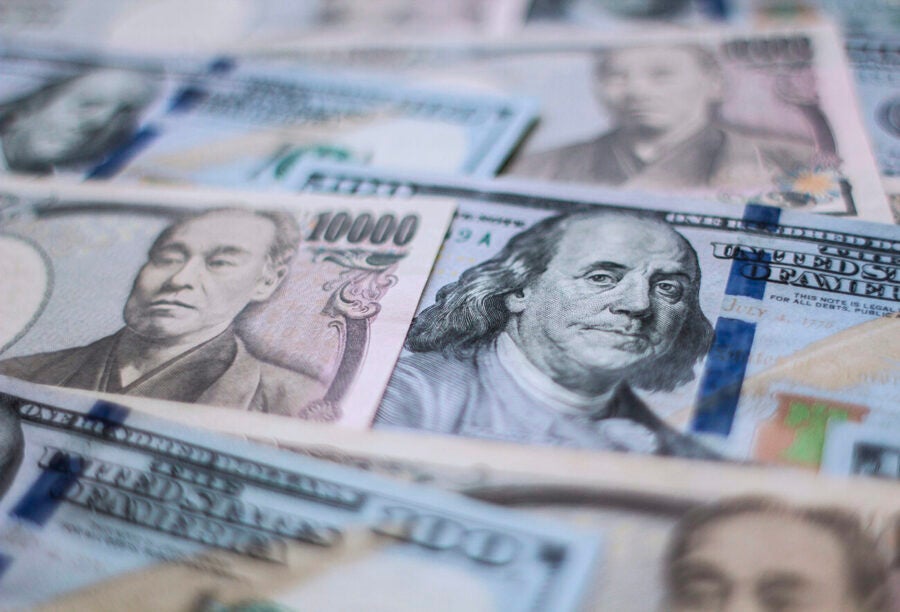The spectacular unwinding of the Yen carry trade raises the question: How big is the carry trade? This is a difficult question to answer. Foreign-exchange traders can simultaneously buy and sell multiple currencies. Exposures in one currency can be quickly hedged or diversified by trading other currencies. In other words, just tallying who traded which currency will not reveal the true extent of carry trades. Not all sales of Japanese yen indicate positions in a carry trade, for example.
Finance professors Amy Wang Huber at Wharton and Yu An at Johns Hopkins University propose to use risk to measure the extent of carry trade exposure in the financial system.
In their new research paper titled “Demand Propagation Through Traded Risk Factors,” Huber and An developed a method to sort foreign exchange (FX) trades into those that cannot be further diversified and thus create risks to dealers and hedge funds that accommodate these trades. They identified “intermediary elasticity” as a way to measure the price compensation financial intermediaries require to bear such trading-induced risks. This intermediary elasticity, they argued, reflects financial intermediaries’ limited risk-taking capacity and shows why trading demand shocks in one currency propagate to other currencies and even other asset markets.
Measuring Risks and Their Price Response
In their paper, Huber and An showed that almost all FX trading-induced risks fall into three categories: the U.S. dollar portfolio, the carry portfolio, and the euro-yen portfolio. Together, these three risks account for 90% of the risk borne by intermediaries in FX trading. The U.S. dollar portfolio is one where investors buy the dollar and sell all other currencies. In the euro-yen portfolio, investors sell the Japanese yen and buy the euro. Finally, the carry portfolio buys all currencies of countries with high-interest rates and sells those of low-interest rate countries; essentially, it exploits arbitrage opportunities between currencies.
These risks capture what is non-diversifiable when dealers and hedge funds accommodate FX trades. Therefore, net flows into these risks measure the intermediaries’ trading-induced risk exposure. For example, the authors found that intermediaries accumulated $0.8 trillion in risk exposure to the carry trade between 2012 and 2023.
Why is it important to measure non-diversifiable risks in FX trading? Huber offered an example: The currencies of Australia and New Zealand tend to move similarly because these two countries share similar economic conditions. Therefore, if some investors buy Australian dollars and sell New Zealand dollars, the risks faced by intermediaries who accommodate these trades are largely diversified away.
“The amount of risk that the intermediary needs to absorb is not the same as the amount of securities traded.”— Amy Wang Huber
Huber stressed that because much of FX trading can be diversified, it is more meaningful to measure price movements in response to changes in the quantity of risk than changes in the quantity of currencies traded. This is the motivation behind intermediary elasticity, which offers an intuitive way to measure the intermediary’s risk-bearing capacity. If the price response to trading-induced risks is zero, then the intermediary is able to perfectly share risks from accommodating trading and the question of limited risk-bearing capacity does not arise. Conversely, the larger the intermediary elasticity, the more limited the risk-bearing capacity.
With intermediary elasticity, it is easy to uncover the impact of trading demand shock in one currency on other currencies or even other asset markets, Huber said. “It all comes down to common risk exposure,” she explained. “When a customer sells a large quantity of Japanese yen, the intermediary who accommodates this trade must hedge out the non-diversifiable risks induced by this trade. This hedge affects the risk price according to the intermediary elasticity. Then, all other currency prices are affected because each currency has some exposure to these non-diversifiable risks.” The same logic uncovers how trading demand shocks in FX propagate to other asset markets.
Highlights from the Paper
The study used a sample of foreign exchange transactions between intermediaries, such as dealers and hedge funds, and their customers from September 2012 to December 2023. The sample covered 17 currencies, including the U.S. dollar, the Australian dollar, the Canadian dollar, and the Korean won. There are three types of customers: funds, which include mutual funds, pension funds, and sovereign wealth funds; non-bank financial entities, including insurance companies and clearing houses; and corporations.
The study estimated the intermediary elasticity for each of the three risks — the dollar, the euro-yen, and the carry. Using sovereign bond auctions in the U.S., Australia, the U.K., Canada, Japan, Germany, and France, the study estimated that intermediaries raise the price by about 1% in response to a $20 billion trading demand shock to the dollar risk, a $10 billion trading demand shock to the carry risk, and a $3.5 billion trading demand shock to the euro-yen factor. Huber explained why the price responses are so large: “We are talking about shock to risks that are non-diversifiable risk. Price responses to trading demand shock in a single security could be much more muted because dealers can diversify across securities. In other words, the amount of risk that the intermediary needs to absorb is not the same as the amount of securities traded. This is the whole point of the paper.”
For the six commonly traded currencies of advanced economies — the Australian dollar, the Canadian dollar, the Swiss franc, the euro, the British pound, and the Japanese yen, the study determined that for every $1 billion in inflows, the price response ranges from 5 bps (basis points) to 16 bps.
“All asset markets are connected. Trading demand shocks originating from the FX market could spread to other asset markets, and vice versa.”— Amy Wang Huber
The study found large cross-elasticity between the Australian dollar, the Canadian dollar, and the British pound. That is, when there is a trading demand shock in the Australian dollar, the Canadian dollar’s price also moves. In contrast, the cross-elasticity is small between the Japanese yen and the Australian dollar, for example, because these two currencies hedge each other in terms of the carry risk exposure.
Finally, the paper showed that common exposure to non-diversifiable FX risks causes spillovers in asset markets such as CDS (credit default swap indices), commodities, corporate bonds, equities, options, and U.S. Treasury bonds. The study estimated that a $1 billion trading demand shock in corporate bonds raises its own price by 5 bps and that for CDS and commodities by similar magnitudes. In contrast, trading demand shocks to U.S. Treasury bonds reduce the price of CDS and corporate bonds.
Three Surprising Findings
The study produced surprises on three fronts, which Huber listed:
- The first is that the intermediary elasticity, or the price response to shocks to non-diversifiable risks, is very high.
- Secondly, the pattern of how currencies are related, particularly the relationship between the yen and the euro. “Both of them are low-interest rate currencies, but they are actually opposite each other in one of the key non-diversifiable risks that we identify,” Huber said.
- Thirdly, the study showed and quantified how trading in the forex market could affect prices in six other asset markets. “All asset markets are connected. Trading demand shocks originating from the FX market could spread to other asset markets, and vice versa.” Huber said.
For regulators, the big takeaway from the paper is that regulations are best designed vis-à-vis the exposure to the amount of risk, as opposed to simply counting the number of securities in a portfolio, Huber said.



